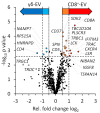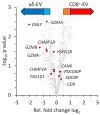Comparative Analysis of Extracellular Vesicles from Cytotoxic CD8+ αβ T Cells and γδ T Cells
- PMID: 39451262
- PMCID: PMC11506423
- DOI: 10.3390/cells13201745
Comparative Analysis of Extracellular Vesicles from Cytotoxic CD8+ αβ T Cells and γδ T Cells
Abstract
Background: Although belonging to different branches of the immune system, cytotoxic CD8+ αβ T cells and γδ T cells utilize common cytolytic effectors including FasL, granzymes, perforin and granulysin. The effector proteins are stored in different subsets of lysosome-related effector vesicles (LREVs) and released to the immunological synapse upon target cell encounter. Notably, in activated cells, LREVs and potentially other vesicles are continuously produced and released as extracellular vesicles (EVs). Presumably, EVs serve as mediators of intercellular communication in the local microenvironment or at distant sites.
Methods: EVs of activated and expanded cytotoxic CD8+ αβ T cells or γδ T cells were enriched from culture supernatants by differential and ultracentrifugation and characterized by nanoparticle tracking analyses and Western blotting. For a comparative proteomic profiling, EV preparations from both cell types were isobaric labeled with tandem mass tags (TMT10plex) and subjected to mass spectrometry analysis.
Results: 686 proteins were quantified in EV preparations of cytotoxic CD8+ αβ T cells and γδ T cells. Both populations shared a major set of similarly abundant proteins, while much fewer proteins presented higher abundance levels in either CD8+ αβ T cells or γδ T cells. To our knowledge, we provide the first comparative analysis of EVs from cytotoxic CD8+ αβ T cells and γδ T cells.
Keywords: CD8+ T cells; cytotoxic T cells; cytotoxic effector proteins; cytotoxic granules; exosomes; extracellular vesicles (EVs); lysosome-related effector vesicles (LREVs); proteomics profiling; αβ T cells; γδ T cells.
Conflict of interest statement
The authors declare no conflicts of interest.
Figures






Similar articles
-
Intra- and Extracellular Effector Vesicles From Human T And NK Cells: Same-Same, but Different?Front Immunol. 2021 Dec 23;12:804895. doi: 10.3389/fimmu.2021.804895. eCollection 2021. Front Immunol. 2021. PMID: 35003134 Free PMC article. Review.
-
Analysis of Cytotoxic Granules and Constitutively Produced Extracellular Vesicles from Large Granular Lymphocytic Leukemia Cell Lines.Cells. 2024 Aug 6;13(16):1310. doi: 10.3390/cells13161310. Cells. 2024. PMID: 39195200 Free PMC article.
-
Circulating CD103+ γδ and CD8+ T cells are clonally shared with tissue-resident intraepithelial lymphocytes in celiac disease.Mucosal Immunol. 2021 Jul;14(4):842-851. doi: 10.1038/s41385-021-00385-8. Epub 2021 Mar 2. Mucosal Immunol. 2021. PMID: 33654213
-
Values for αβ and γδ T-lymphocytes and CD4+, CD8+, and CD56+ subsets in healthy adult subjects: assessment by age and gender.Cytometry B Clin Cytom. 2012 Jul;82(4):238-44. doi: 10.1002/cyto.b.21020. Epub 2012 Apr 26. Cytometry B Clin Cytom. 2012. PMID: 22539222
-
Expression of cytotoxic proteins in peripheral T-cell and natural killer-cell (NK) lymphomas: association with extranodal site, NK or Tgammadelta phenotype, anaplastic morphology and CD30 expression.Leuk Lymphoma. 2000 Jul;38(3-4):317-26. doi: 10.3109/10428190009087022. Leuk Lymphoma. 2000. PMID: 10830738 Review.
References
Publication types
MeSH terms
Substances
Grants and funding
LinkOut - more resources
Full Text Sources
Research Materials

